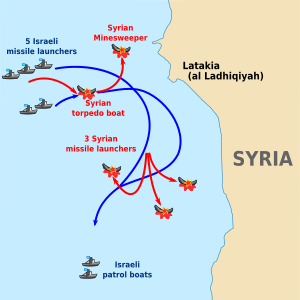Battle of Latakia
From Wikipedia, the free encyclopedia

This article
needs additional citations for verification. Please help
improve this article by
adding citations to reliable sources. Unsourced material may be challenged and removed.
(June 2010) (Learn how and when to remove this template message)
Coordinates:
35.52105°N 35.726114°E
Battle of Latakia
Part of the
Yom Kippur War

Diagram outlining the Battle of Latakia
Date 7 October 1973
Location near
Latakia,
Syria
Result Decisive
Israeli victory
Belligerents
Israel Syria
Commanders and leaders
 Michael Barkai
Michael Barkai Fadal Hussein
Strength
5 ships 5 ships
Casualties and losses
None All vessels sunk
Unknown casualties
[hide]
Yom Kippur War
The
Battle of Latakia (
Arabic: معركة اللاذقية;
Hebrew: קרב לטקיה) was a small but revolutionary naval battle of the
Yom Kippur War, fought on 7 October 1973, between
Israel and
Syria. It was the first naval battle in history to see combat between
surface-to-surface missile-equipped
missile boats and the use of
electronic deception.
[1]
At the outset of hostilities, the
Israeli Navy set out to destroy the naval capabilities of the Syrians, who were equipped with
Soviet Komar and
Osa class missile boats. The Syrian missile-boats were equipped with Soviet manufactured
P-15 Termit (
NATO reporting name: SS-N-2
Styx)
anti-ship missiles with twice the range of the Israeli
Gabriel anti-ship missiles.
[2]
The four Israeli Navy
Sa'ar 3-class and one
Sa'ar 4-class missile boats headed towards the Syrian
port of Latakia in two parallel columns. In the western column were the missile boats Miznak (Blast), Ga'ash (Storm), and Hanit (Lance) and in the eastern column the missile boats Mivtach (Reliance) and Reshef (Spark)). At 22:28 hours the Israelis encountered the Syrian K-123
torpedo boat which was sunk with 76mm cannon fire from Mivtach and Hanit. Then as they headed toward the shore, they encountered a 560-ton Syrian
T43-class minesweeperand sank it, using four
Gabriel anti-ship missiles. At 23:30 the Israelis made contact with two Syrian
Komar and one
Osa class missile boats. The Syrian missile boats fired their missiles at long range. As the missiles approached, the Israelis employed
electronic countermeasures and
chaff rockets to avoid being hit, with success. When the Israeli missile boats reached the range of their own missiles they fired five
Gabriel missiles and sank one
Komar and one
Osa class missile boat immediately and damaged the second
Komar. The surviving Syrian missile boat tried to escape, but it was stuck in shallow waters and was destroyed by 76 mm cannon fire at 00:26 hours.
During this naval clash Syrian missile boats launched missiles from within the port limits (actually launched while the missile boats were moored between merchant ships in port). These missiles malfunctioned or lost guidance and hit 2 merchant vessels anchored along the
piers. Both ships (one Greek and one Japanese) were hit in the engine rooms.
The
Syrian Navy remained bottled up in its
home ports for the rest of the war.
While the Battle of Latakia was the first naval battle in history between missile boats, it was not the first incident in which a missile boat sank another ship using missiles. That had happened when one
Egyptian Soviet-built
Komar class sank the British-built Israeli
destroyer Eilat on 20 October 1967, shortly after the
Six Day War, using two to four
P-15 Termit surface-to-surface missiles.
[3][4]






 Ei hyvää päivää.
Ei hyvää päivää.

